|
The two most sought after choreographers of the moment – Alexei Ratmansky and Liam Scarlett – are given exciting exposition in San Francisco this season. The forty-two year-old Russian who used to direct the Bolshoi and now is artist in residence at ABT in New York, presented his full-length “Shostakovich Trilogy,” a co-production between ABT and San Francisco Ballet. Twenty-eight year-old Brit Liam Scarlett, dancer and artist-in-residence at the Royal Ballet London, wrote “Hummingbird” for SF Ballet, set to the Tirol Concert by Philip Glass. I saw the West Coast opening of the “Shostakovich Trilogy” last year, but missed Scarlett’s world premiere (also in 2014) and had the revelation now of two top-notch choreographies performed almost neck to neck (Program 3 and 4), ripe for comparisons.
Shostakovich Trilogy
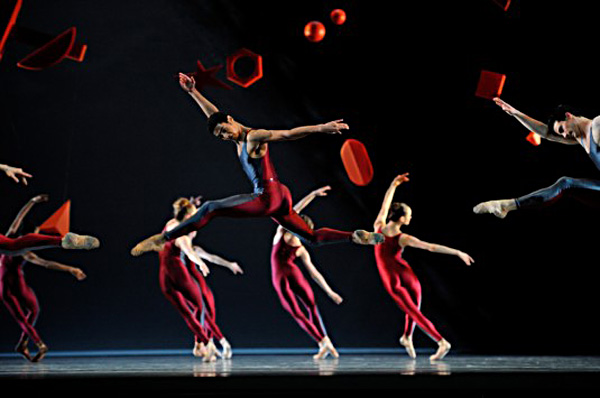
Seeing the ballet language of both pieces, you instantly notice that these choreographers have been looking around in the world of movement beyond the classical ballet studio. While both are solidly rooted in tradition, they deliver classical ballet “with a twist” (Scarlett). Both spill out a cornucopia of inventive movements inspired, for example, by ballroom dancing, lifts and throws from figure skating, acrobatics, and of course diverse forms of modern dance. Ratmansky comes across as more attuned to the history of ballet: there are the Balanchine quotations in sudden strict line formations of the group or when one male dancer leads three women in gentle daisy-chains à la “Apollon Musagète.” There are hip- and shoulder-slants and torques in off-balance Forsythe-style, and bent backs in droll, medieval reverence to Mark Morris. Ratmansky likes to replace straight, extended legs with bent legs and jutting knees, letting his ballerinas gracefully hop with both knees jutting sideways. By contrast, the women are carried aloft with straight, open legs in the second position. Then again they launch themselves dangerously into the air and are caught by their partners, not to be enthroned in classical ballet glory, but hanging there limply like lovely rags on a washing line.
You can tell the dancers love Ratmansky’s vocabulary, the quick shifts of group formations he creates attuned to the composer’s music: now one group embodies the strings, another the woodwinds, then they break apart and a solo picks up the trumpet. The pronounced musicality of his style insists that movements never end in a solid position, a pause, a break, as you would expect in classical ballet. The dancer is always led onward into another counter-move or épaulement twist-and-slide that continues the musical phrase against the percussive beat.
The excitement of watching this new ballet language did not carry through the entire Shostakovitch evening, however, partly due to the music itself which is dissonant and not always easily engaging. I wonder if Ratmansky’s frequent choice of this Russian composer has something to do with Balanchine’s collaboration with Stravinsky, but the shock of Stravinsky’s music paired with Balanchine’s “abstract” dance revolution is long gone.
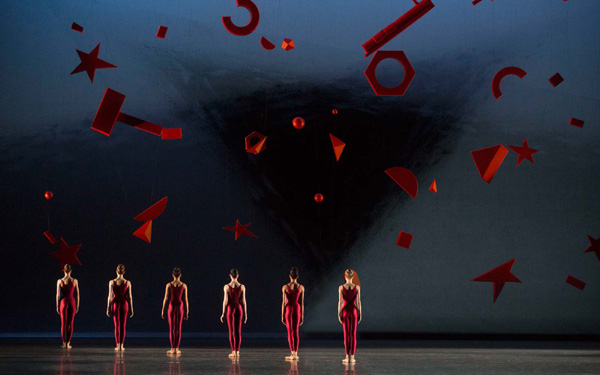
The degree of abstraction is a problem in this seemingly long program. Ratmansky allows only very small allusions of story elements, loosely attached to the composer’s difficult existence under Stalin. In part one, “Symphonie # 9,” one could imagine a Russian youth movement in some exuberant groupings, a note of military parading, and perhaps the celebration of a young hero, danced with aplomb and superb elevation by a coprs member who got his moment in the spot light and shone: Francisco Mungaba, a dancer to be watched.
The second part, “Chamber Symphony,” falls rather flat with programmatic and conventional movements of repression and paranoia: the groups now clash with a bare-chested artist in a red-lined, black velvet jacket (Ruben Martin Cintas who apparently represents the composer) in less than thrilling contortions. He appears divided within himself and divided about three women (Shostakovitch’s three wives) who lack personality (Clara Blanco, Vanessa Zahorian, Dana Genshaft) and represent the “eternal” and, alas, repetitive feminine. The pairings don’t do justice to the deeply stirring, yearning music in minor key of this Chamber Symphony.
The last part, “Piano Concerto # 1,” brings back some verve in entertaining group movements that seem to gain double speed through the back and forth of dancers clad in costumes that present the women in frontal red leotards with grey backsides, and the men in the opposite color scheme. The piece is centered on two couples, and here the two ballerinas fully carry the action. Both in red, shiny bathing suits, they are outstanding in their contrast: Sofiane Sylve with her cat-like languor and beautiful, impressive limbs, and small, quick-silver Frances Chung, adequately partnered by Tiit Helimets and Joan Boada.
Hummingbird
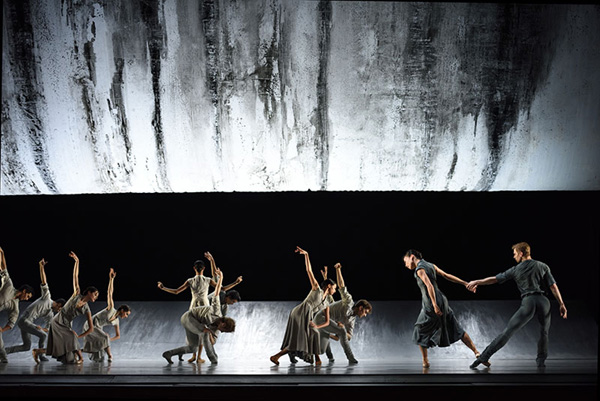
If I had to make a choice between the two choreographies, I would give Liam Scarlett the prize for creative imagination. His higher energy and speed are irresistible, propelled by the intense, throbbing score of Philip Glass. The “Tirol Concerto for Piano and Orchestra” is, in the choreographer’s description, “a complex, methodical, layered piece with different counterpoint melodies from what you’d expect.” Its amazing how the continuous, repetitive waves of harmonies get “organized” rhythmically and thematically by the dance. Call it the energy and speed of youth, but there is more: Scarlett creates unexpected emotion and therefore psychological interest in everything he does. He also has a knack for the dramatic use of space. A metallic “wall,” interesting to look at with its urban patina, closes off the space mid-stage, but rolls up now and then to reveal a floor rise like the edge of a skateboard rink. Dancers crawl and slide from the darkness behind that edge; then the “wall” rises further and one dancer appears as if at a great distance, watching what is going on onstage -- like a mysterious presence exacting an as yet unseen influence. Three couples successively dominate the foreground and are acted on by small groups of dancers who seem to comment and sometimes imitate the pas de deux in front of them. Scarlett doesn’t tell a clear story either, but there is continuous tension and revelation in his narrative: in the dramatic shifts of light and shadow and sudden changes from three-dimensional bodies to silhouettes; in his play with distance versus close-up and threesome versus couple versus group.
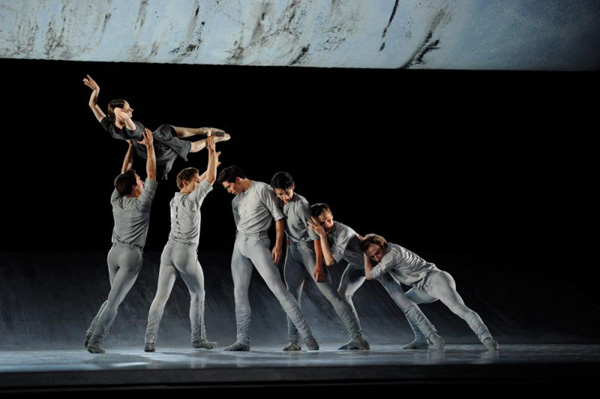
The San Francisco Ballet dancers, for whom “Hummingbird” has been written, throw themselves into the task with exuberance. Frances Chung, in the first couple, and tiny Maria Kotchevkova in the third, beautifully partnered by Gennadi Nedvigin and Joan Boady, leap off the stage like birds, the first couple expressing the high spirit of comradeship, the third a more intimate tenderness of romance. In between, Yuan Yuan Tan -- San Francisco Ballet’s reigning ballerina at her most expressive--and sensitive Luke Ingham dance the ambivalence of dominance and submission in a deeply stirring pas de deux that evokes the pains of an addiction.
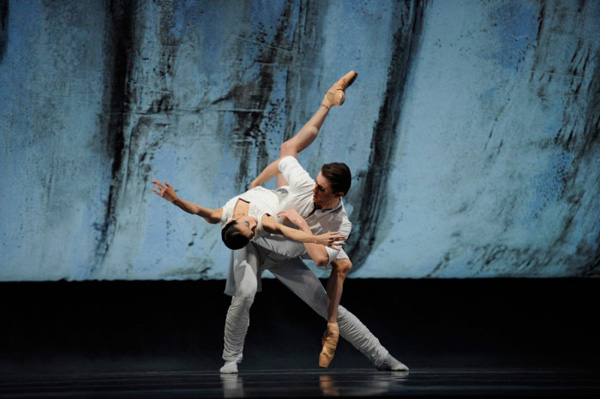
The ballet only fills half an evening and has to meet the challenge of coming right after “Dances at a Gathering” by Jerome Robbins, set to piano music by Chopin. “Dances” is regarded as one of the most brilliant pieces of ballet of the past fifty years, and while it was once again performed to perfection by the company, the bigger miracle and joy was to see Scarlett’s “Hummingbird” soar right up to the level of excitement set by the first half of this inspired programming.
Photos - Erik Tomasson
|